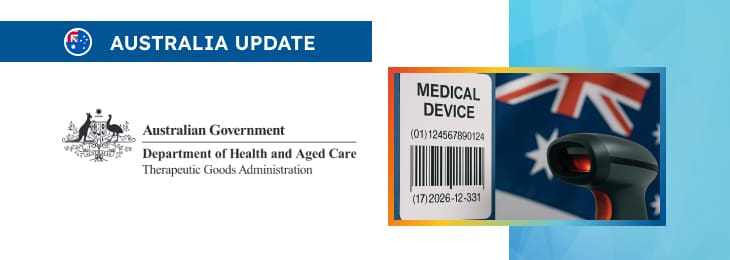The document provides an overview of the applicable regulatory requirements in the sphere of unique device identification.

Table of content
The Therapeutic Good Administration (TGA), an Australian regulating authority in the sphere of healthcare products, has published a guidance document dedicated to the UDI timelines. The document describes in detail the relevant regulatory requirements, and also provides additional clarifications and recommendations to be taken into consideration by medical device manufacturers and other parties involved in order to ensure compliance. At the same time, provisions of the guidance could be subject to changes, should such changes be reasonably necessary to reflect corresponding amendments to the underlying legislation.
The guidance is intended to assist sponsors and manufacturers in understanding their regulatory obligations under Australian therapeutic goods legislation with respect to the Unique Device Identification (UDI) system. It outlines when and how UDI compliance applies to medical devices and in vitro diagnostic (IVD) devices. It also complements existing TGA guidance and clarifies specific requirements, terminology, and timelines.
Regulatory Background
The Australian Government has introduced a UDI system to improve patient safety, regulatory effectiveness, and the ability to trace and identify medical devices. The UDI system will assist in post-market surveillance activities, including recalls and safety alerts. It also enables better global harmonisation of medical device regulation.
The UDI regulatory framework came into effect on 24 March 2025. Key components of the framework include:
- Requirements for UDI Carriers on device labels and packaging;
- Mandatory submission of UDI records to the Australian Unique Device Identification Database (AusUDID);
- Direct marking requirements for certain reusable devices;
- Staggered compliance dates based on device risk classification.
These obligations were established through amendments to the Therapeutic Goods Act 1989 and the Therapeutic Goods (Medical Devices) Regulations 2002.

UDI Compliance Timeframes
The implementation of UDI is being phased in over five years. High-risk medical devices will be the first to comply, followed by medium- and lower-risk devices. This staged approach allows sponsors and manufacturers to prepare accordingly.
Before the mandatory compliance date for a device, sponsors may voluntarily meet the UDI requirements. This preparatory period allows sponsors to organise internal systems, update device labels, create UDI data, and test their chosen method of submission to AusUDID. Early compliance is encouraged, especially for those submitting large volumes of data or using automated (machine-to-machine) submission pathways.
UDI Compliance Start Dates
Compliance dates vary based on:
- The device’s risk classification (e.g. Class III, IIb, IIa, or Is for medical devices; Classes 1–4 for IVDs);
- Whether the device is supplied under EU MDD or IVDD certification (transitional periods may apply);
- Whether the device is considered an “existing” device, manufactured prior to the relevant compliance date.
Failure to meet UDI requirements may result in regulatory actions such as suspension from the ARTG fines, or infringement notices. If a sponsor cannot comply on time, they must apply in advance for “Consent to Supply” and demonstrate valid justification.
UDI Compliance Milestones
According to the guidance, there are two major UDI compliance milestones:
- Labelling and UDI Record Submission. Sponsors must apply the UDI Carrier to device labels and relevant packaging. They must also submit the UDI-Device Identifier (UDI-DI) and associated data to the AusUDID within 30 days of the device’s next supply in Australia. The data must link to the ARTG ID and be kept up to date. For implantable devices, the UDI must appear on the Patient Implant Card and in notifications to the TGA (e.g. adverse events or recalls).
- Direct Marking and Submission of Direct Marking Data. Reusable devices that require direct marking must include this marking and update the UDI record in the AusUDID accordingly. This requirement only applies where direct marking is relevant.
UDI Compliance Dates
Medical Devices:
- Class III and Class IIb medical devices must meet labelling and data submission requirements by 1 July 2026. Direct marking requirements for these classes begin on 1 January 2028 for Class III and 1 January 2029 for Class IIb devices. Implantable devices are exempt from direct marking.
- Class IIa medical devices must meet the labelling and data submission requirements by 1 July 2027, with direct marking (if applicable) from 1 January 2029.
- Class Is (low-risk) medical devices must meet the UDI labelling and submission requirements by 1 July 2028, and direct marking (where required) from 1 January 2029.
IVD Devices:
- Class 4 and Class 3 IVDs must meet UDI labelling and data submission requirements by 1 July 2028, with direct marking applicable from 1 July 2029.
- Class 2 and Class 1 IVDs must comply with labelling and data submission requirements by 1 July 2029, and direct marking from 1 July 2030.
Relabelling and Management of Existing Devices
If these devices were manufactured and labelled before 1 July 2026 and remain within the sponsor’s control after 1 July 2029, they must be relabelled to be UDI-compliant. The UDI record must also be submitted to the AusUDID if not done already.
Devices that are still in the sponsor’s possession (e.g. stored in a warehouse) are considered under the sponsor’s control and must be relabelled. Devices already distributed or supplied before the compliance date are exempt from UDI requirements for the rest of their usable life.
Devices from other classes (e.g. Class Is or Class IIa) manufactured before their UDI compliance dates are exempt from UDI requirements and may be supplied without relabelling.
If a device is relabelled after its compliance date, all UDI requirements apply, including data submission. However, direct marking is not retroactively required
Refurbished Devices
As explained by the TGA, refurbished devices may be considered new devices under the Regulations. The requirements depend on the refurbisher:
- If the refurbisher is not the original manufacturer, they are treated as the new manufacturer and must assign a UDI and comply with all obligations, including ARTG inclusion;
- If the refurbisher is the original manufacturer and the device’s intended purpose and model have not changed, the existing ARTG entry may still be used;
- If the refurbished device’s intended purpose or model changes, it is no longer considered the same device and must comply fully with UDI requirements, including direct marking if applicable.
The authority additionally emphasizes that refurbished devices are not exempt from direct marking.
Alignment with EU MDR/IVDR Transition Timeframes
To align with the European Union’s MDR and IVDR transitions, the TGA has established transitional timelines for devices supplied under extended MDD and IVDD certificates.
For example, if a Class III medical device is supplied under a valid MDD certificate in the EU, its Australian UDI compliance date is extended to 1 January 2028, rather than the standard 1 July 2026. Once the device becomes MDR-compliant, the Australian UDI requirements must be met immediately.
Similar extensions apply to other classes of devices, based on their EU certification status. If a device becomes MDR-compliant earlier than the EU transitional deadline, Australian UDI requirements must also be met sooner.
New Applications under MDD Certificates
For new ARTG applications relying on expired MDD certificates, sponsors must show that the manufacturer qualifies for MDR extension. Transitional arrangements will then apply, delaying the need for full UDI compliance until the extended date.
Devices Certified under MDR
Devices already MDR-compliant must meet Australian UDI requirements according to the regular risk-class-based compliance timeline. No transitional delays are available for these devices.
How Can RegDesk Help?
RegDesk is an AI-powered Regulatory Information Management System that provides medical device companies with regulatory intelligence for over 120 markets worldwide. It can help you prepare and publish global applications, manage standards, run change assessments, and obtain real-time alerts on regulatory changes through a centralized platform. Global expansion has never been this simple.

